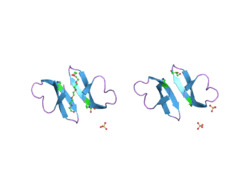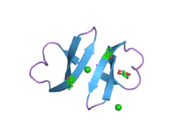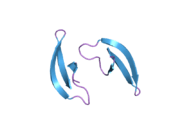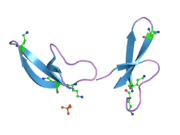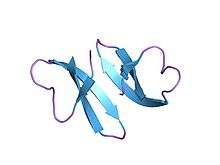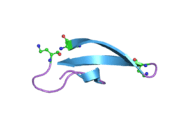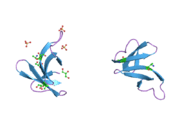DEFA3
Defensin, alpha 3 (DEFA3) also known as human alpha defensin 3, human neutrophil peptide 3 (HNP-3) or neutrophil defensin 3 is a human protein that is encoded by the DEFA3 gene.[3] Human alpha defensin 3 belongs to the alpha defensin family of antimicrobial peptides.
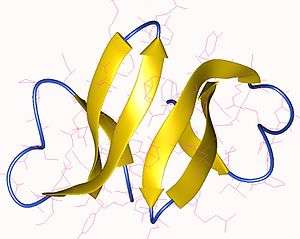
Function
Defensins are a family of microbicidal and cytotoxic peptides thought to be involved in host defense. They are abundant in the granules of neutrophils and also found in the epithelia of mucosal surfaces such as those of the intestine, respiratory tract, urinary tract, and vagina. Members of the defensin family are highly similar in protein sequence and distinguished by a conserved cysteine motif. Several alpha defensin genes are clustered on chromosome 8. The protein encoded by this gene, defensin, alpha 3, is found in the microbicidal granules of neutrophils and likely plays a role in phagocyte-mediated host defense. Several alpha defensin genes are clustered on chromosome 8. This peptide differs from defensin, alpha 1 by only one amino acid. This gene and the gene encoding defensin, alpha 1 are both subject to copy number variation.[3]
References
- ENSG00000284835 GRCh38: Ensembl release 89: ENSG00000239839, ENSG00000284835 - Ensembl, May 2017
- "Human PubMed Reference:". National Center for Biotechnology Information, U.S. National Library of Medicine.
- "Entrez Gene: defensin".
Further reading
- Kocsis AK, Ocsovszky I, Tiszlavicz L, et al. (2009). "Helicobacter pylori induces the release of alpha-defensin by human granulocytes". Inflamm. Res. 58 (5): 241–7. doi:10.1007/s00011-008-8100-z. PMID 19169650.
- Strausberg RL, Feingold EA, Grouse LH, et al. (2002). "Generation and initial analysis of more than 15,000 full-length human and mouse cDNA sequences". Proc. Natl. Acad. Sci. U.S.A. 99 (26): 16899–903. doi:10.1073/pnas.242603899. PMC 139241. PMID 12477932.
- Aldred PM, Hollox EJ, Armour JA (2005). "Copy number polymorphism and expression level variation of the human alpha-defensin genes DEFA1 and DEFA3". Hum. Mol. Genet. 14 (14): 2045–52. doi:10.1093/hmg/ddi209. PMID 15944200.
This article incorporates text from the United States National Library of Medicine, which is in the public domain.
